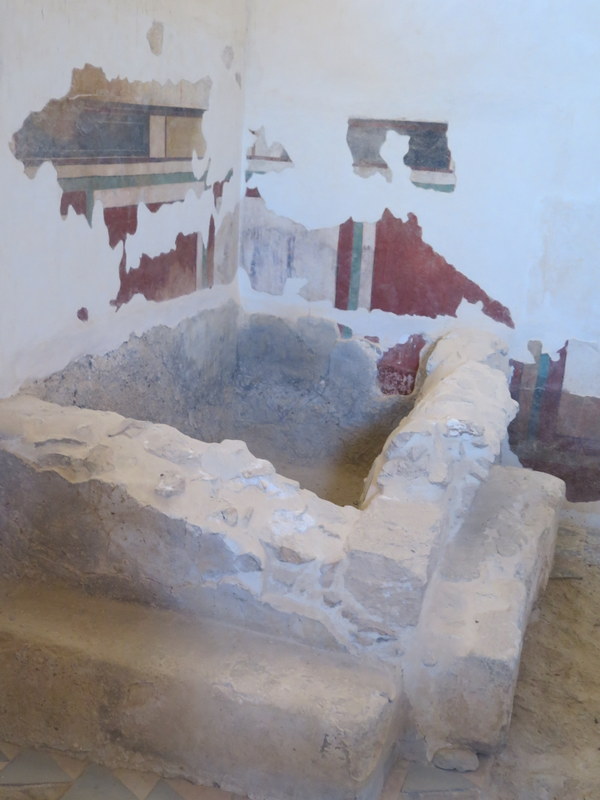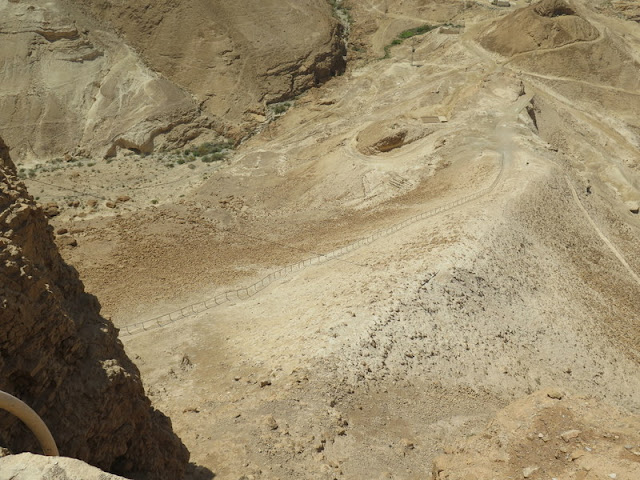Photo: Inside Masada's visitor's center. Have any of you seen the movie,"Masada"? It was filmed in 1981 starring Peter O'Toole and filmed onsite at Masada. The details and historical accuracy of the movie is impressive. From the uniforms and the war machines to the setting of the camp of 8,000 Roman soldiers, the movie accurately portrays what happened when the determined Romans planned to seize the fortress and capture almost 1,000 Isralites (Sicarii). The ending is tragic.
Photo: Cable car mount.
The story is complicated and I hope my facts are correct. Herod the Great left his family at Masada which was first fortified by Alexander Jannaeus when he went to Rome to be named King of Judea (103-76 BC). During his reign, Herod rebuilt and enlarged Masada which was comprised of two palaces, a swimming pool, Roman bath, storage buildings, and a case-mate wall (a space between two walls that is reinforced with mud or straw) that included living quarters and a dining hall for soldiers. Mules brought supplies to the mountain on the "Snake Path," a very narrow path to the top.
Photo: Arial view from cable car. Josephus Flavius was the commander of the Galilee during the Great Revolt. At the time of Masada's conquest, he was in Rome. According to Josephus, Masada was first constructed by the Hasmoneans between 37 and 31 BCE; then Herod the Great fortified it as a refuge for himself in the event of a revolt.
We spent three hours at this site and there was so much to see. Below is one of 29 long excavated rooms used for the storage of food, liquids, and weapons.
Photo: Unexcavated storage room.
Photo: Outside the bath house.
Photo:Bath house.
Photo: The inside of the bath house was elaborate and it was evident it had been carefully planned. Bathhouses were an integral part of Roman culture. You would enter into a dressing room, paved floors and fresco-adorned walls. Hot air flowed under the double floor; the upper floor stood on brick and stone columns. Hot air flowed under the floor and rose through the clay pipes embedded in the walls. Nearby was a basin to where hot water was channeled. The room had wide, faulted ceilings.
Photo: Roman bath.
Photo: Inside bath house.
Photo: Notice the tile marks on the walls of the bathhouse.
Clay tiles were reconstructed and modeled after the originals. The tiles were hollow which allowed the steam to flow upward and into the room.
Photo: Northern Palace.
Photo: Steps to Northern Palace. The Northern Palace was built on three rock terraces and supported by very impressive retaining walls. The palace was built to host high-ranking visitors and to allow the King his solitude. Herod and his family lived on the upper level and the two lower levels were for receptions. The rooms were paved with mosaics in geometric patterns and the walls were plastered and covered with frescoes.
Herod's palace was truly incredible!
Photo: When we got to the area of the Northern Palace, we came to a large, open area with columns.
To build the each column, cylindrical-shaped stones were stacked, plastered and then grooves were carved out to make each column appear fluted.
Photo: Walking along the Northern Palace edge.
Photo: Cistern.
Photo: Western Palace and room where Herod had his throne. Notice the black lines on the walls? These lines mark where the original walls were excavated then additional stones were added to build up the walls.
Photo: Tile floor in Western Palace.
Photo: Western Palace wall.
According to Josephus, Masada was the last rebel stronghold in Judea. In 73 CE, the Roman Tenth Legion laid siege to the mountain. The legion, consisting of 8,000 troops among which were auxiliary forces, built eight camps around the base, a siege wall, and a ramp made of earth and wooden supports on a natural slope to the west. Captive Jews brought water to the troops, apparently from En Gedi, as well as food.
Photo below: This is the ramp the Romans built up to Masada.
Photo: It took the Romans months to haul dirt and rocks to build the ramp.

Photo: Tower built by the Romans. The Romans eventually breached the walls of Masada. There was no battle, for the defenders of Masada had committed suicide rather than die at the hands of the Romans.
















































Incredible. I bet the bible really comes to life when you're able to see these places and learn the history.
ReplyDelete